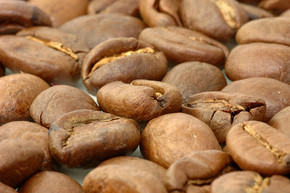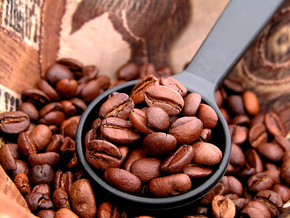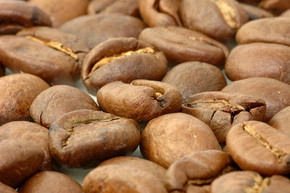Does Robusta have boutique coffee beans? a brief introduction to the "Coffee Royal" grade in India.
Follow the caf é (Wechat official account vdailycom) and found that Beautiful Cafe opened a small shop of its own.
People always habitually look at things in dichotomy, good and bad, good and evil, good and bad. The same is true in the world of coffee.
"arabica" coffee beans are always classified as "good", while its distant relative "Robusta" coffee beans are often classified as "bad". We may describe it this way: if Arabica is a gift from angels, Robusta is like the booger of the devil, always despised and spurned by coffee gluttons.

Why is Robusta so notorious? Robusta beans, which are round in appearance and look like soybeans at first glance, are also known as thick and strong beans. They have strong resistance to diseases and insect pests, large output and low price. The boutique coffee industry used to have a very poor impression of Robusta because it usually does not have a charming and meticulous flavor. The bigger problem is that because the setting is a low-cost product, most of the planting methods are very rough, resulting in a bad smell. It often smells like dirt, dirt, and sometimes even a smell like charred tires and burning plastic.
Ten years ago, I had a chance to taste several cheap Vietnamese robusta beans, some of which were unforgettable because they were like charred wheat tea flavored with tires, and I couldn't help spitting them out with the other nine bad flavors. I don't want another sip.
Wow! If Robusta beans are so bad, why talk about it? That's a good question! As mentioned at the beginning of this article, everything has its advantages and disadvantages. Good beans take you to heaven, rotten beans let you hang your heart! This is true of Arabica, and Robusta is no exception! In fact, under the tide of boutique coffee in recent years, exquisite robusta beans with high standard treatment have appeared in the world! The representative of boutique India Kappi Royale beans is India's Robusta (Robusta "Kappi Royale" Robusta).
Kappi Royale means "top grade". At present, there are at least four (and growing) private coffee farms in India to grow and produce high-quality "Coffee Royal" and "Kappi Royale" Robusta coffee beans with refined Arabica standards and procedures! It includes exquisite full water washing treatment and Pulp Natural mucosal drying semi-washing treatment which is popular in recent years.
The advent of the "Coffee Royal" grade exquisite Robusta beans has undoubtedly begun to change the world's impression of Robusta! Most people who have drunk it will be surprised by its thick and clean characteristics. Because of the exquisite planting and handling procedures, the flavor of the Royal Coffee Robusta is mostly quite clean, without the intrusive flavor of the cheap Robusta (off-flavors).
The Robusta is born without the elegant aroma of Arabica beans, replaced by a thicker, calmer taste, as well as strong walnut, peanut, hazelnut and wheat flavors like peanut butter and hazelnut.
India's "Coffee Royal" grade Robusta currently produces very little, but it has begun to attract the attention of the elite of the boutique coffee industry all over the world. Italian coffee expert David Schumann C. Schomer's famous Seattle-based Espresso Vivace began adding 14% of India's "Royal Coffee" Robusta to its Italian formula beans as early as a decade ago. Paradise Roasters, the national coffee evaluation points champion roaster, took the lead in the North American boutique coffee market, launching 100% Indian CxR espresso in 2009, and received a Coffee Review rating of 90 and 91 points in 2009 and 2010! It proves that Robusta is not what it used to be!
Incidentally, the price of Robusta is not cheap, even more expensive than many Elaraby beans! So, from now on, please stop saying: Robbins are rotten beans-after all, times have changed! With the emergence and gradual attention of high-quality Robusta, it is bound to cause some chain reactions and changes to the culture of boutique coffee.
Important Notice :
前街咖啡 FrontStreet Coffee has moved to new addredd:
FrontStreet Coffee Address: 315,Donghua East Road,GuangZhou
Tel:020 38364473
- Prev

Description of the flavor of robusta coffee beans. How to distinguish robusta coffee beans?
Follow the caf é (Wechat official account vdailycom) found that the beautiful cafe opened its own small shop, "Robusta" coffee, commonly known as "thick beans", can be grown in low altitude areas (200m to 800m above sea level), strong resistance to diseases and insect pests, not vulnerable to agricultural pests, the annual output of coffee trees per unit area is higher, the use of machines to harvest a large number of coffee, in general, the production cost is much lower than A
- Next

An introduction to the History and Culture of Robusta
Following Cafe Review (official account vdailycom of Wechat) found that Beautiful Cafe opened a small shop of its own. If you want to ask the country or region that loves Roberta beans most, the first place is Italy, the hometown of espresso! If you narrow it down, to be more precise, the largest amount of robusta beans are used in southern Italy, such as Palermo.
Related
- Detailed explanation of Jadeite planting Land in Panamanian Jadeite Manor introduction to the grading system of Jadeite competitive bidding, Red bid, Green bid and Rose Summer
- Story of Coffee planting in Brenka region of Costa Rica Stonehenge Manor anaerobic heavy honey treatment of flavor mouth
- What's on the barrel of Blue Mountain Coffee beans?
- Can American coffee also pull flowers? How to use hot American style to pull out a good-looking pattern?
- Can you make a cold extract with coffee beans? What is the right proportion for cold-extracted coffee formula?
- Indonesian PWN Gold Mandrine Coffee Origin Features Flavor How to Chong? Mandolin coffee is American.
- A brief introduction to the flavor characteristics of Brazilian yellow bourbon coffee beans
- What is the effect of different water quality on the flavor of cold-extracted coffee? What kind of water is best for brewing coffee?
- Why do you think of Rose Summer whenever you mention Panamanian coffee?
- Introduction to the characteristics of authentic blue mountain coffee bean producing areas? What is the CIB Coffee Authority in Jamaica?

